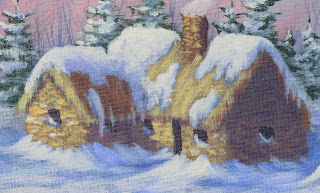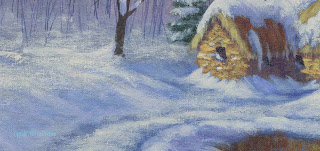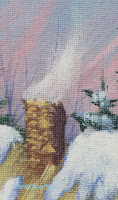Winter
Acrylic Class Project: Cozy Cottage Week 5
This week we
worked on finishing up the house and starting the highlighting on the snow.
You will be
able to continue to paint while areas are drying if you remember to move around
your painting. I started with the house by adding some detail to the thatch of
the roof, stones or whatever you want your hose to be made of, detailed out the
chimney and added some smoke, then I came back in a started the highlighting of
the snow on the cottage. While things were drying on the house so I could work
on it some more, I started to highlight the snow.
One thing you
all need to understand is none of this is instant. If you want your painting to
look the way you see it in your mind’s eye, you are going to need to do layers
of color from dark to light to give it shape and form, there are no shortcuts
if you want it done correctly which means you need to be patient with the
process and follow the steps. There will be several steps to the highlighting
of the snow to get the brightest highlights in, partly because acrylics dry
darker but also it gives more depth and texture to your snow if each time you
leave a bit of what you did before as the shadows and forms in your snow,
please, please, please(!) do NOT cover it all up with white all of these layers
are important.
The thatching
on the roof needs some brighter highlights and while they are near yellow in color,
the yellow by itself is too bright so mix your yellow with a touch of burnt
sienna and white to mare a golden color, then using the dry brush technique,
and a flat bristle brush, follow the angle of the roof and brighten the thatch
in the sunlit areas (see photo). Add a touch more sienna to this color – it
should still be a warm golden color – and tape in some shapes onto the walls of
your house on the sunny sides. You can also use this on the front of the
chimney. Remember, these are stones in all shapes and sizes so just suggest
these stones and let your under painting become the mortar between the stones.
 On the
shadowed sides of the roof, you can add more sienna to that color if you still
have some along with a touch of orange and any mud (grey) you might have on
your palette tiny touch of blue if you don’t, this color should be lighter than
what you have on your roof already if not lighten with either more orange or
white but add small amounts to adjust the value. Dry brush this color into the
shadowed sides of the roof then add a touch of purple and white to create a
shadow color for the shadowed sides of the house. Add the stones into the
shadowed side the same as the sunny side.
On the
shadowed sides of the roof, you can add more sienna to that color if you still
have some along with a touch of orange and any mud (grey) you might have on
your palette tiny touch of blue if you don’t, this color should be lighter than
what you have on your roof already if not lighten with either more orange or
white but add small amounts to adjust the value. Dry brush this color into the
shadowed sides of the roof then add a touch of purple and white to create a
shadow color for the shadowed sides of the house. Add the stones into the
shadowed side the same as the sunny side.
While that
was drying, I mixed up a light blue color to start the highlighting of the roof
of the house by starting with the tinted white I had mixed up previously (gesso
or white with a teeny, tiny touch of orange just to tint it) and to that I
added a little blue. This combination makes a soft bluish grey color that should
be lighter than the under painted snow I have on the roof already.
Still using
my #4 flat bristle brush and looking at the reference photo – which you should
all have right in front of you BTW – I started adding some shape and
intermediate highlights to the roof’s snow. Again, I am not trying to cover up
all of the under painting, I am trying to add form to the flat color that is
there.
You can use
this same color to add some more intermediate highlights around the front of
the house, on the snow around the sides of the house and the top of the wood
pile if you put it in. As always, watch your angles and THINK about what you
are doing and WHY. Snow covers everything, it drifts up over things and forms
lumps and bumps along the way so keep this in mind as you paint.
Once your
house and roof are dry, you can add a bit of detail if you want. If you want
smoke coming out of the chimney, take the tinted white or even some gesso, tap
it around the top of the chimney, then with your finger just smudge it up and
let it fad to nothing, that’s all there is to it. If you want to put in windows
you need to mix a dark color (blue, purple, sienna and or Hooker’s green to
make a dark color) and paint in the windows and door, you can also use this
color for the shadows up under the eaves of the roof. When this is dry you can
add snow piles to the windows if you want. Details are up to you.
The next
thing you need to do is start highlighting the rest of the snow, this won’t be
the final highlights those will come when everything is in and you are doing
the final touches but these do set the stage for the final highlights. As I
have said many times before, if you want to be a fine art painter you cannot
skip steps. You cannot go straight from A to Z without the rest of the
alphabet. Just because this is white (we will actually be using the tinted
white with orange), when it dries it will be darker just because of the nature
of acrylics but it is going to add so much to your painting, you don’t want to
skip it.
Still using
my #4 flat bristle, and I am using the bristle brush because I am going to be scrubbing
this color on which is very hard on the brush, I will be using the tinted white
(gesso with a tiny touch of orange) and using the dry brush technique and the
small side of my brush, I will be scrubbing this color onto my snow where I
think the light will be hitting.
PLEASE,
PLEASE, PLEASE!!! Look at the photos. Some of that cooler shading I did earlier is not
going to get much if any of this warmer color because the area is in the shadows.
This is where all that under painting starts to shine. As you add the highlight
colors, you will see depth and dimension start to pop in your painting DO NOT
COVER IT ALL UP!
Also, THINK
about what you are painting and where you are painting. Remember that the snow
is lumpy so don’t cover over everything that is to be highlighted. Use the
highlights to shape the ruts of your road better and to highlights the drifts
of snow on the house and around the trees and fence posts. You are going to
need to look at the photos and really see what is going on BEFORE you start
painting it. Do the best you can but please take your time to do it right the
first time because it will save you time in the long run.
So keep
painting and I will see you in class.





